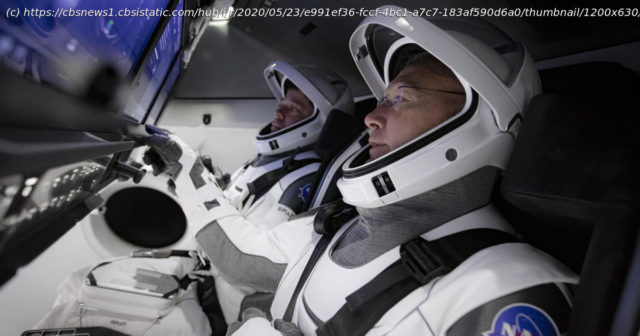The first launch of astronauts from U.S. soil since 2011 marks a milestone for NASA — and private sector space travel.
Watch live coverage on CBSN this Saturday, May 30. Launch is scheduled for 3:22 p.m. EDT.
Opening a new chapter in American spaceflight, two veteran space shuttle fliers will blaze a fresh trail to orbit aboard a SpaceX Crew Dragon spacecraft Saturday, weather permitting — the first launch of American astronauts from U. S. soil since the space shuttle’s final flight nearly nine years ago. The original launch date of Wednesday had to be scrubbed due to bad weather.
The historic mission, the first orbital flight of a new piloted spacecraft in 39 years, is the culmination of a six-year, multibillion-dollar NASA drive to end the agency’s sole reliance on Russian Soyuz spacecraft for transportation to and from the space station.
The government-financed, privately owned and operated astronaut ferry ships will enable NASA to expand the space station’s crew to seven, including four full-time NASA and partner agency astronauts, maximizing the amount of research that can be carried out in the $100 billion lab complex.
The mission, known as Demonstration Test Flight No.2 — Demo 2 — will mark the second launch of a SpaceX Crew Dragon and the first with astronauts on board. If no major problems are found, the agency is expected to certify the spacecraft for operational space station crew rotation missions, clearing the way for launch of a three-man, one-woman crew this fall.
Longer term, NASA also expects the Commercial Crew Program, under which SpaceX and, eventually, Boeing, will launch private citizens as well as professional astronauts, to open up the high frontier to private sector development, including privately operated space stations.
« This is a new generation, a new era in human spaceflight, » said NASA Administrator Jim Bridenstine. « NASA has long had this idea that we need to build, own and operate hardware to get to space. And in the past that has been true.
« But now in this new era, NASA, especially in low-Earth orbit, has an ability to be a customer, one customer of many customers in a very robust commercial marketplace…. We want to have numerous providers that are competing against each other on cost and innovation. And that’s really what we are entering into with this new era of human spaceflight. »
Despite the COVID-19 pandemic and agency-wide workforce restrictions, Crew Dragon commander Douglas Hurley, the pilot of the final shuttle mission in July 2011, and crewmate Robert Behnken flew to the Kennedy Space Center ton May 20 to begin final preparations.
They looked on Friday, May 23, as SpaceX test fired the their booster’s nine first-stage engines, then donned their spacesuits and strapped in the following day for a dress rehearsal countdown. If all goes well, they will blast off Saturday at 3:22 p.m. EDT and dock with the International Space Station about 19 hours later.
« It’s tremendously exciting to be where we are, on the cusp of launching a commercial crew vehicle, » Hurley told Vice President Mike Pence during a video chat last week with the National Space Council. « It’s an exciting time to be in the space business…. I almost wish I was a young astronaut again because it’s going to be an exciting time for folks who fly in space. »
NASA normally would expect enormous crowds across Florida’s « Space Coast » to share that excitement, especially for the first such flight in nearly a decade. But the Kennedy Space Center remains closed to non-essential personnel, part of NASA’s agency-wide response to the coronavirus pandemic.
And so, for the first time in decades, NASA will not open the space center for public launch viewing and has sharply limited the number of journalists on site while implementing strict social distancing protocols.
« The challenge that we’re up against right now is we want to keep everybody safe, » Bridenstine said. « That’s the number one, highest priority of NASA, keeping people safe. And so we’re asking people not to travel to the Kennedy Space Center.
« We don’t want an outbreak. We need a spectacular moment that all of America can see and all of the world can see to inspire not just those of us who’ve been waiting years for this, but to inspire the generations that are coming. And we need to do it in a way that’s responsible.
« So we’re asking people not to travel to Kennedy but to watch on line or watch on your television at home…. But we’re asking people not to make the trip to Kennedy. »
That includes the crew’s extended families and friends. Instead of being able to invite scores of guests to share the excitement of launch, the usual NASA practice, Hurley’s wife, retired astronaut Karen Nyberg, and fellow astronaut Megan McArthur, Behnken’s wife, were limited to just 15 guests each.
« We were looking forward to celebrating with lots of people who could physically come to the Cape and enjoy watching the launch in person, » McArthur said. « But I have gotten so many notes of support from people all over the country saying hey, we’re still going to be with you, we’re going to be watching from home, but we’re still cheering Bob and Doug on, you know — go, Dragon! — and so people are still really, really excited about it. »
Hurley and Nyberg have one son,10-year-old Jack, as do Behnken and McArthur,6-year-old Theodore.
« One good thing for us, the positive side, is that our sons have been basically quarantined from other children for two months, » said Nyberg. « So they do get a little extra time with their dads closer to launch, which is nice. »
The immediate families plan to watch the launch from the roof of NASA’s Launch Control Center just 3.2 miles from pad 39A.
Launching directly into the plane of the space station’s orbit, the Falcon 9 will climb away on a northeasterly trajectory atop 1.7 million pounds of thrust from its first stage engines.
As has become commonplace with SpaceX, the rocket’s first stage, after powering the spacecraft out of the thick lower atmosphere, will attempt to land on an off-shore droneship while the second stage continues the climb to orbit. Twelve minutes after liftoff, the Crew Dragon will be released to fly on its own.
Home
United States
USA — Science "It's tremendously exciting": NASA astronauts counting down to historic launch aboard SpaceX...






